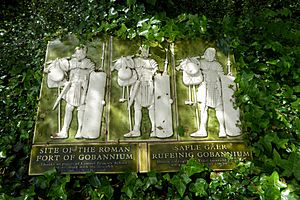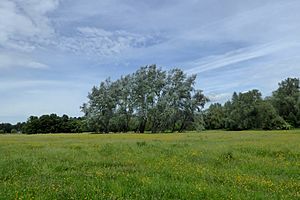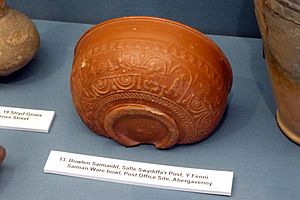Gobannium facts for kids
Gobannium was a Roman fort and a small town built by the Roman legions when they invaded what is now Wales. Today, the remains of Gobannium lie hidden beneath the modern market town of Abergavenny, in Monmouthshire, south east Wales. It was an important place for the Romans as they expanded their control across Britain.
Contents
How Do We Know About Gobannium?
Historians and archaeologists learn about ancient places like Gobannium from old writings and things found in the ground.
Ancient Records
Gobannium is mentioned in two important Roman documents:
- The Antonine Itinerary: This was like an ancient Roman road map from the late 2nd century AD. It listed Gobannium as 'Gobannio'. It said the fort was about 12 miles from Burrium (which is now Usk) and 22 miles south of Magnis (now Kenchester).
- The Ravenna Cosmography: This was a list of places from around the 7th century AD. It called the fort 'Bannio'. It placed it between Isca Augusta (a big Roman fortress in Caerleon) and Bremia (at Llanio).
What Does the Name Mean?
The name 'Gobannium' likely comes from an old Celtic or Brythonic language. It is thought to be linked to the Celtic gods Gobannus and Gofannon. The name probably means 'the place of the blacksmiths'. This suggests that metalworking might have been important there.
Where Was Gobannium Located?
Gobannium was built in the wide valley of the River Usk. This area is surrounded by hills and mountains, like the Sugar Loaf Mountain, the Skirrid, and the Blorenge. Even before the Romans arrived, people lived here during the British Iron Age and British Bronze Age. The valley was a major route for people travelling through the land of the Silures tribe. It connected the coastal areas to the Brecon Beacons.
Why Did the Romans Choose This Spot?
The Romans, led by Publius Ostorius Scapula, needed a good stopping point in this area. It was important for their soldiers to have a place to rest and resupply between their main bases and other forts deeper inland. Gobannium also had links to major Roman roads, like Watling Street to the north, and other towns like Blestium (now Monmouth) and Glevum (now Gloucester).
The Romans picked a natural spur of land that rose steeply above the River Usk. This was a great defensive spot, especially where the smaller River Gavenny joined the Usk. It offered clear views of the surrounding landscape. The flat ground on top of the spur was perfect for building a fort and later a small civilian settlement next to it.
What Have Archaeologists Found?
Archaeologists have found many interesting things at the site of Gobannium. These finds help us understand what life was like there.
Artefacts and Discoveries
Some of the items found include:
- Roof Tiles: Some tiles had the stamp of the Legio II Augusta, a Roman legion based at Isca Augusta (Caerleon). This shows that this legion was involved in building or supplying the fort.
- Coins: Roman coins, including one from the time of Emperor Augustus, have been found. These coins were well-used, showing that trade happened here.
- Pottery: Sixteen pieces of high-quality Samian ware pottery have been discovered. This type of pottery was often used by important people.
- Military Equipment: Pieces of bronze military equipment have been found. These items were similar to those used by Roman auxiliary troops, who were non-Roman soldiers helping the Roman army.
- Rubbish Pits: Old rubbish pits have given archaeologists clues about what people ate and used daily.
Excavations Over Time
Archaeological digs at Gobannium have been small and done over many years. They often happen when new buildings are planned in Abergavenny town centre.
- 1960s Digs: Between 1962 and 1969, digs for a new post office and telephone exchange found evidence of military ditches, timber buildings with postholes (holes where wooden posts stood), small granaries (for storing grain), and turf and timber walls.
- Later Discoveries: Since 1970, more explorations have revealed walls made of wattle and daub (a mix of woven branches and clay), clay sling ammunition, and more rubbish pits.
The Abergavenny 'Leopard Cup'
In 2002, a metal detectorist found a special cup in a field near Pentwyn Triley Farm. This cup had a unique handle shaped like an animal, which is why it's called the Abergavenny 'Leopard Cup'. It was briefly shown in Abergavenny and is now displayed at the National Museum and Galleries Wales in Cardiff. Experts are still discussing where it came from and how it was used.
You can see some of the amazing things found at Gobannium at the Abergavenny Museum, which is located within Abergavenny Castle.




